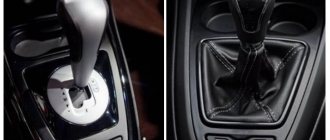Lada Vesta Cross, now also a sedan. Buy? Or is the SW Cross station wagon better?
Vladimir Melnikov drove a Vesta Cross sedan along the serpentines around Sochi - and... Buy? Or is it the SV Cross station wagon? Be sure to watch the video to the end!
Subscribe to the site so we can make new videos for you: https://autoreview.ru/subscribe
VKontakte group: https://vk.com/autoreview Community on Facebook: https://www.facebook.com/Autoreview Instagram: https://instagram.com/autoreview_ru Twiiter feed: https://twitter.com/AutoreviewRu
Korea CANNOT DO THIS! VESTA CROSS SEDAN first test 1.8 manual
What's wrong with the Lada Vesta Cross sedan? What is the point of buying it? Autospot TV Channel https://www.youtube.com/AutospotTV New Car Aggregator - https://autospot.ru/?utm_source=ytb&utm_medium=coc&utm_term=vestasedancross&utm_campaign=testdrivenew
Author and presenter Mikhail Kuldyaev https://vk.com/mkuldyaev Presenter Alexander Azanov https://vk.com/ae_azanov Editing Vladimir Dobrov https://vk.com/vsdobrov Videographer Alexander Sudarikov https://vk.com/alexsudarikov
Not as spectacular as in the AvtoVAZ photos: the first real photos of the Lada Vesta Sport have appeared
Car enthusiasts doubt the prospects of the sports sedan: the dynamic characteristics were not as impressive as expected.
The sports modification of the Lada Vesta is already arriving at dealerships, although the official premiere of the model is scheduled for the last days of August, when the Moscow Motor Show opens its doors. This information can be confirmed by photographs that have appeared on the Internet: in the photographs, a dark steel-colored Vesta Sport is parked near one of the capital’s dealership centers.
Apparently this is the basic version.
A little less than a month has passed since AvtoVAZ demonstrated a production copy of the sports sedan. The production car, as expected, did not receive significant external differences from its prototype shown in 2016. Its main distinguishing elements are original-shaped bumpers, sill skirts, a spoiler placed on the tailgate, as well as a body kit in a sporty style. The front fenders are made of plastic materials and are slightly expanded, the rear bumper is decorated with an imitation diffuser, and the front bumper is decorated with a lower spoiler.
Vesta Sport looks more interesting in official photos
An interesting fact is the absence of stickers on the sides of the body on the copy captured in the photo, which were present both on the concept two years ago and on the production version shown in corporate press images. Probably, such stickers will be reserved for more expensive versions of the sports sedan. However, car enthusiasts note the lack of a wow effect: a production car without these design solutions looks quite modest.
The main power unit for Vesta Sport is a modified 1.8-liter VAZ engine, which received new camshafts (they have increased cam lift values), a fuel system with increased pressure and a controller with reconfigured calibration. As a result of the modification, it was possible to achieve an output of 145 “horses” (the original engine had 122 hp) and an increase in torque to 187 Nm (from the previous 173 Nm). The engine is paired with a mechanical five-speed transmission from Renault, which has a cable-type drive. The declared “maximum speed” of the sports sedan is 198 km/h, while it takes 9.6 seconds to accelerate to the first “hundred”. A regular sedan needs 11.2 seconds for this: car enthusiasts note that a difference of 1.6 seconds is not enough to call the car sports.
The cost and available configurations of Vesta Sport are not yet known. Most likely, all this will be announced at MIAS 2018, where the car will debut. Presumably, dealers will ask for about 900 thousand rubles for the Lada Vesta Sport.
Lada Vesta Cross Sedan - should I buy it? News of the Russian Automotive Industry Lada Vesta Cross Sedan | Zenkevich
Test drive and review of Lada Vesta Cross Sedan Lada Vesta Cross Sedan 2018 – a new representative of the Russian automobile industry. I've had a decent ride in the car and I'll tell you all about my impressions, without advertising or complaining - to the point. Don’t forget if you liked the review - subscribe, have already subscribed - share it on social media. networks!
PROMOTION. LOOK HERE. (so that they don’t say later that I don’t announce discounts) Promotion from Suprotec, only for my subscribers. https://clck.ru/E5SAN
My Instagram: https://instagram.com/ivanzenkevich/ MY LIVE CHANNEL WITHOUT FORMAT AND RULES: https://goo.gl/Ca5BZl
SUPROTEC General partner of the “People's Automobile Magazine” company https://suprotec.ru/ __________________________________________________________
All Test drives of VAZ cars: ▶ https://goo.gl/kz5UG7
My live channel, without format and rules: ▶ https://goo.gl/Uw4Yem __________________________________________________________
SUPROTEC General partner of the People's Automobile Magazine company https://suprotec.ru/
#lada #vesta #vesta #ladavesta #Lada #VAZ #sedan #Ivanzenkevich #procars #zenkevich
Universal values: Our test drive of Lada Vesta SW Cross (+Video)
Lada Vesta SW Cross is definitely a hit this fall. The cross-station wagon caused no less resonance than the appearance of Vesta herself. And, it would seem, just a body version... What is the secret of such interest? As soon as the opportunity arose, we took Vesta Cross for a test and will try to find out.
While waiting for their Vesta Cross, those who had not previously been seen favoring the products of the domestic automobile industry are eagerly shaking their wallets. And those who bought a Vesta sedan a year ago certainly want to switch to a cross-station wagon. There were a lot of people like this constantly crowding around, the only test car at the dealer was literally bursting.
But some are stopped by the price; all Crosses, at least for now, come in the Lux configuration and are priced from 756 thousand. And on the test there is a car with a 1.8 liter engine, “mechanics” in the pre-maximum Lux Multimedia configuration for 805 thousand rubles. Top performance Prestige with “robot” costs 858 thousand. However, those for whom the “cross” markups are high can turn their attention to the regular SW station wagon, where prices are more affordable and start from 640 thousand.
And it’s good that we got a car with a “mechanics” for the test, since the “robot” is the only thing we didn’t like during the sedan test. They say that in the future they will install a variator on Vesta, but this, it seems, is not the best option. Is it worth changing the “tough for soap”? In a word, in our opinion, until Vesta acquires a normal torque converter “automatic”, let it be better to have a “mechanics”.
There are obvious strengths and advantages of Vesta Cross, which will be discussed later, and not so obvious ones, which are also worth mentioning. It seems to me that one of the attractive advantages is that, contrary to the opinion of the majority of all-knowing marketers, many consumers of class B+ cars are simply tired of just solid sedans, alternatives to which cannot be found during the day. And potential buyers were inspired in anticipation of at least something new, especially in such an attractive wrapper.
Indeed, Vesta SW Cross is one of the few domestic cars that will be chosen simply because of its good looks. The sedan is also not bad, but the cross-wagon from Steve Mattin’s team turned out to be especially good. The sloping roof, the sporty slope of the rear window, a lot of spectacular details, and the overall silhouette is proportional and harmonious. Moreover, during development it was possible to save money: the rear lights and bumper were transferred to the station wagon from the sedan without changes. And among the new products, in addition to the universal body itself, there were also rear disc brakes, a gas filler flap with a button, and a trunk lock button, a dual exhaust pipe, a fin antenna, 17-inch wheels and new colors, especially the spectacular orange-copper “Mars” " In total, the station wagon has about 60 new parts, and there are also body reinforcements in the rear.
Vesta Cross is perhaps not only the most attractive, but also the most advanced domestic car, which contains all the latest VAZ developments. And the chassis is no longer configured anyhow. If a regular SW station wagon has only a centimeter longer rear springs compared to a sedan, then the Cross version has all its own original springs and shock absorbers, and the settings were selected experimentally from 40 options. As a result, the Cross rides tightly, smoothly and elastically, without excessive sway or roll, despite the increased ground clearance by 25 mm. Of course, you can rock the car, but you need to provoke it by making several sharp movements with the “sharp” steering wheel back and forth, especially on pliable winter tires, which dealers hastened to change the car’s shoes on without waiting for real frosts. Well, in normal modes the Cross is absolutely adequate and drives like a car no worse than a sedan. In general, the steering is pleasant and informative, but for my taste, the steering wheel lacks a little reactive force in the near-zero zone and a clear zero. It is possible that this handling feature is precisely related to winter tires. But the good thing is that at least they are not noisy, and the sound insulation of Vesta Cross turned out to be excellent. In any case, there are soundproofing mats on the inside of the hood, unlike, for example, some popular Korean cars that do not offer them even in the maximum configuration.
The new 122-horsepower 1.8-liter engine tempts you with the opportunity to get a few horses in reserve compared to the base 1.6-liter engine. But, in fact, in terms of traction and dynamic capabilities, it is not much different from it. It does not indulge in torque either at low or high speeds, and is only good in the medium speed range, and the maximum speed, quite obviously, is higher than a car with a 1.6 liter engine. There are no complaints about the French “mechanics”, there is only one oddity - the fifth one is turned on, as if through a rubber latch. As for fuel consumption, no miracles happened here either. A heavier and taller car with large tires with increased rolling resistance, a larger engine and, as a result, fuel consumption in the urban cycle is 10.7 liters per “hundred”, which is almost 2 liters more than that of a sedan with a 1.6 engine. So, each buyer will decide for himself whether he needs it or not.
The braking properties of the car with new disc rear brakes were expectedly good. However, Vesta had no problems with the drums at the back. We can say that more powerful brakes successfully compensated for the extra hundredweight of curb weight.
Of course, the 200 mm ground clearance did not make the car an all-terrain vehicle. The extra space under the bottom is useful, especially on potholes; there is less chance of sitting “on your belly” in the folds of the primer or getting caught by the bumper. But after a day's rain, the clay became soft and instantly sealed the tread of the winter tires, turning them into “slicks.” And without all-wheel drive it’s difficult here, the car slides sideways, doesn’t obey the steering wheel, and even turning off the traction control system doesn’t really solve anything. In a word, experiments on cross-country ability had to be curtailed. Well, at least we didn’t get stuck and managed to paddle ourselves onto the hard surface.
There is no point in dwelling on the interior decoration and the almost flawless ergonomics of the Vesta inside; everything here is exactly the same as in the sedan. Let's touch only on some of the innovations and distinctive features of the station wagon. The updated instrument lighting does not radically change anything, but the box armrest is a comfortable thing, it is neatly trimmed with pleasant leatherette and is located in the optimal area. Pass! A rearview video camera has appeared, which transmits a clear picture with dynamic marking lines to the display of the multimedia system. There is navigation with voice prompts, but in sunny weather, if the light source is behind, the screen glares desperately, so much so that it blinds the driver, and at this time, of course, nothing is visible on the display.
The arrangement on the rear sofa is almost no different from the sedan; it is also spacious and cozy, but there is more headroom, since the ceiling in the station wagon is a couple of centimeters higher. An additional courtesy lamp has appeared in the rear seat area. Another nice option: a retractable rear armrest and a heated rear sofa are now available in the maximum configuration.
Here we come to a topic that should be moved to the beginning of the article; the trunk is the main distinguishing feature of the car, an outstanding element in the literal and figurative meaning, another property for which people will buy this car. The opening, of course, could have been wider and lower. But, as already mentioned, the rear bumper came from the sedan, and, therefore, the opening and loading height remained unchanged. The wide roof pillars that cramp the opening of the fifth door are a tribute to safety, there’s no getting around it. But the opening is still considerable and quite comfortable, thanks to the high door that partially extends onto the roof. The inside of the trunk lid has good-quality lining and two grippy handles for closing. And inside!.. Something that has not yet been found in any domestic car, and there are few foreign cars where the luggage space would be so well thought out. Although the total volume does not surprise with record capacity figures, it will be extremely convenient to use. To begin with, there is a sliding, removable curtain, and the finishing materials are good and neat. No more burning and flimsy plastic or sagging fiberboard for flooring. Everything is reliable and of high quality, just like in a good foreign car.
Under the curtain there is the same 480 liters of volume as the sedan. The backsplash is made up of two durable flaps, lined with a pleasant fleecy material, underneath which are two fairly voluminous organizer trays that span the entire width of the trunk. They are made of durable pressed foam and are perfect for any small item from documents to tools or dirty things. Both trays are exactly the same size and can be swapped, as can the lids above them. If the trays are pulled out and removed altogether, then the volume for luggage in the trunk will already be 575 liters. Under the trays, already on the third floor, there is a niche for a spare wheel with car accessories and another container for things. The hard trunk floor looks very durable and can withstand considerable loads. To secure cargo and place things, there are three standard luggage nets, loops in the floor and hooks on the sides. There is additional lighting and a 12-volt outlet. There are a couple of niches on the left side of the trunk, one of which has a fastening strap for a 5-liter bottle. And on the right there is a “secret place” with a lid and good interior decoration.
The transformation is carried out in the usual way: the back of the rear sofa is reclined in parts, and then the volume for luggage is 825 liters, and if loaded under the ceiling, then much more. In a word, AvtoVAZ has created a practical and attractive car in “one bottle”, which has never been seen in its arsenal. It remains to be seen how Vesta Cross, and even an ordinary station wagon, will perform in real use. And what else would I like to wish for is that the number of trim levels increases and not so much up as down, and more affordable versions appear that are available to a wide range of consumers.
Technical characteristics of Lada Vesta SW Cross (Manufacturer data)
- Body - 5-door, monocoque, steel
- Number of seats - 5
- Dimensions, mm
- Length - 4410
- Width - 1785
- Height - 1532
- Base - 2635
- Ground clearance – 203
- Curb weight, kg - 1350
- Gross weight, kg - 1730
- Trunk volume, l - 480/575/825
- Engine – petrol
- Number and arrangement of cylinders - 4, in a row
- Volume, l - 1.8
- Power - 122 hp. at 5900 rpm
- Torque - 170 Nm at 3700 rpm
- Transmission - 5-speed manual
- Drive - front
- Front suspension - independent, spring, McPherson
- Rear suspension - semi-independent, spring
- Maximum speed, km/h - 180
- Acceleration time from 0 to 100 km/h, s - 11.2
- Fuel consumption per 100 km, l
- Urban cycle - 10.7
- Suburban cycle - 6.4
- Mixed cycle - 7.9
- Fuel – gasoline AI-92-95
- Tires – 205/50 R17
Video test drive of Lada Vesta SW Cross in Kazan
Photos from the test drive of Lada Vesta SW Cross in Kazan
The car for the test drive was provided by the KAN AUTO car dealership.










